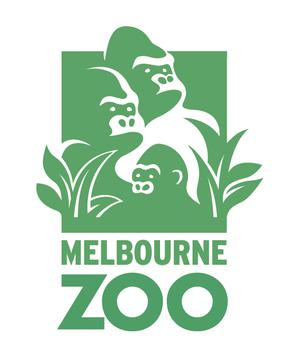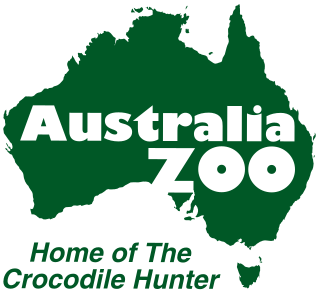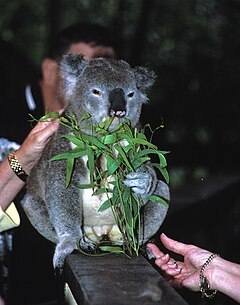
Brisbane Water National Park is a national park on the Central Coast of New South Wales, Australia. The national park is situated 70 kilometres (43 mi) north of Sydney and 12 kilometres (7.5 mi) southwest of Gosford. It consists the Brisbane Water and Mooney Mooney Creek waterways.

Melbourne Zoo is a zoo in Melbourne, Australia. It is located within Royal Park in Parkville, approximately 4 kilometres (2.5 mi) north of the centre of Melbourne. It is the primary zoo serving Melbourne. As of 2021, the zoo contains 3742 animals comprising 243 species, from Australia and around the world. The zoo is accessible via Royal Park station on the Upfield railway line, and is also accessible via tram routes 58 and 19, as well as by bicycle on the Capital City Trail. Bicycles are not allowed inside the zoo itself.

WIRES Wildlife Rescue is the largest wildlife rescue & rehabilitation charity in Australia. It is a non-profit organisation providing rescue and rehabilitation for all native Australian fauna. All animal rescuers and carers are volunteers. It is funded by public donations and operates throughout the most populous Australian state, New South Wales.

Australia Zoo is a 700-acre (280 ha) zoo in the Australian state of Queensland on the Sunshine Coast near Beerwah/Glass House Mountains. It is a member of the Zoo and Aquarium Association (ZAA), and is owned by Terri Irwin, the widow of Steve Irwin, whose wildlife documentary series The Crocodile Hunter and his family's new show Crikey! It's the Irwins made the zoo a popular tourist attraction.

Lone Pine Koala Sanctuary is an 18-hectare (44-acre) koala sanctuary in the Brisbane suburb of Fig Tree Pocket in Queensland, Australia.

Currumbin Wildlife Sanctuary is a heritage-listed zoological garden at 28 Tomewin Street, Currumbin, Queensland, Australia. It was built in 1947 onwards. It was added to the Queensland Heritage Register on 18 September 2009. The sanctuary is world-renowned for its feeding of huge flocks of free-flying wild rainbow lorikeets, which come to the sanctuary to feast off the special mixture which the lorikeets eat.

A brumby is a free-roaming feral horse in Australia. Although found in many areas around the country, the best-known brumbies are found in the Australian Alps region. Today, most of them are found in the Northern Territory, with the second largest population in Queensland. A group of brumbies is known as a "mob" or "band".

Village Roadshow Theme Parks is a division of Village Roadshow Limited which operates theme parks and attractions in Australia and the United States of America. The Sydney Attractions Group Pty Ltd was formerly part of Village Roadshow Theme Parks; however, it was sold in 2011 to Merlin Entertainments.

The Rosamond Gifford Zoo at Burnet Park is an AZA zoo in Syracuse, New York. It is owned and operated by Onondaga County Parks with support from the Friends of the Rosamond Gifford Zoo. The zoo is home to more than 900 animals representing 216 species on 43 acres (17 ha). Some of the more popular animals include Asian elephants, Humboldt penguins, Amur tigers, a Komodo dragon and the only Giant Pacific octopus exhibit in Central New York. The zoo opened a new Animal Health Center in 2022 that is the largest zoological medical center in New York state outside of the Bronx Zoo.
RSPCA Australia is an Australian peak organisation established in 1981 to promote animal welfare. Each state and territory of Australia has an RSPCA organisation that predates and is affiliated with RSPCA Australia.

Wild Life Sydney Zoo is a wildlife park in the Darling Harbour precinct, on the western edge of the Sydney central business district, Australia. Opened in September 2006, the zoo is located adjacent to a leisure and retail precinct that includes the Sea Life Sydney Aquarium and Madame Tussauds Sydney.

Cohunu Koala Park is a wildlife sanctuary on 14 ha of bushland at Byford, near Perth, Western Australia.

Billabong Zoo is a 10-acre (4.0 ha) wildlife park and koala breeding centre located in Port Macquarie, New South Wales, Australia. It was opened in 1986, and features a wide variety of Australian and exotic animals.

Dreamworld Corroboree is a collection of wildlife attractions at the Dreamworld amusement park on the Gold Coast, Queensland, Australia. The area is divided into several subsections which allow guests to view the animals in their natural habitats. Dreamworld Corroboree is a registered zoo with 800 native and barnyard animals located within the Dreamworld grounds.

Featherdale Wildlife Park is a zoo located in Doonside, Sydney, Australia. The park is located in Sydney's west, approximately 40 km (25 mi) from Sydney's CBD. The park contains various species native to Australia, and is known to be one of the world's largest collections of Australian fauna. The facility provides displays, events and interactive experiences. The site covers 3.29 hectares, ranging from animal enclosures and display areas to visitor facilities, including picnic spaces, shops and basic amenities. It specialises in Australian native wildlife and birds, as well as reptiles and marsupials. The premises is accredited by the Zoo Aquarium Association Australia.
Noel Burnet was an Australian environmentalist and founder of the Koala Park Sanctuary, a privately owned and run wildlife park located at West Pennant Hills, New South Wales, Australia. He was a Fellow of the Royal Zoological Society of New South Wales.

Wildlife HQ Zoo, is located at the Big Pineapple, Woombye, Queensland on the Sunshine Coast, Queensland and opened in November 2013. In March 2014 many animals were relocated from the now closed Alma Park Zoo.

Koala conservation organisations, programs and government legislation are concerned with the declining population of koalas, a well known Australian marsupial found in gum trees. The Australian government declared the species as endangered by extinction in 2022.




















